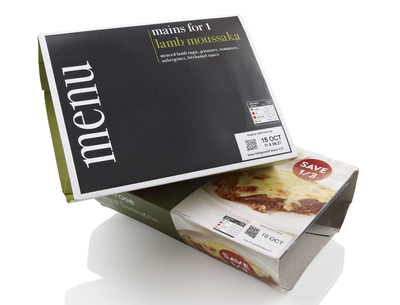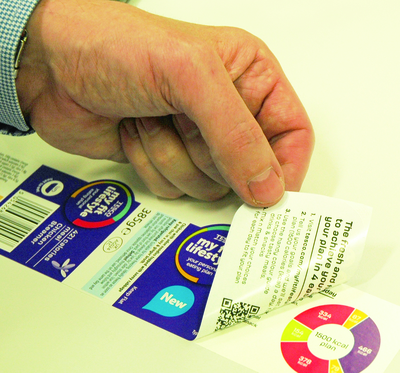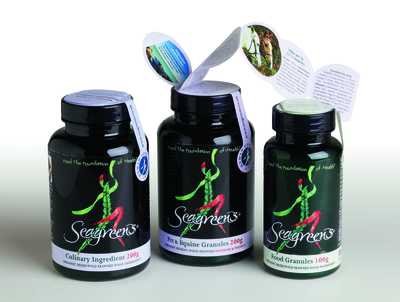Peel and read labels and booklet labels are growing. This multi-page leaflet label for Seagreens was produced by Fix-a-Form
With the impending introduction of a new EU regulation, label printers are facing up to the prospect of striking a balance between entertainment and education, reports Des King.
The Food Information Regulation (FIR) (EU Regulation 1169/2011) that comes into force this December has been flagged up by Campden BRI, the food and drinks industry’s leading independent R&D body, as ‘the biggest change in labelling legislation for a generation’. Whilst it can never eliminate acts of purposeful dishonesty, such as last year’s ‘Horsegate’ scandal, the legislation’s overarching intention is to make the process of consumption safer. The strict controls that it seeks to establish have been common knowledge for the past three years, so how geared up is the retail supply chain to implement them?
In summary, FIR requires an extended level of mandatory information to be included on the label (and also the brand owner or retailer’s website) including a full list and respective volumes of ingredients, a prominently highlighted warning about allergens, the use by date, a nutritional declaration (carbohydrates, fats, sugar, etc) and details of provenance. It will also be necessary to adopt a minimum font size of 1.2 mm for all packs whose labelling surface is 80 cm² or above (and 0.9 mm for packs below that area).
Whilst welcoming the intentions of the regulation, implementation could result in some unintended consequences, cautioned M&S primary foods packaging technologist, Kevin Vyse. ‘The legislation is a good step in ensuring packaging is inclusive, provides accurate information and protects consumers. We have taken this very seriously and will of course be fully compliant by the deadline, mainly because we were already applying most of the regulations anyway. There have been areas, however, where we have had to increase pack size to accommodate the additional information, but with some intelligent planning and careful construction it has been possible to minimise this kind of impact.’
Tried and tested solutions
Two existing labelling formats have experienced a revival of interest in anticipation of the terms of the directive being enacted: peel & read and the multi-page leaflet label. ‘We’ve seen this uplift in demand for peel and read solutions growing significantly over the past six months,’ said Berkshire Labels business development specialist, Andrew Brozowski. ‘Some packs can be quite small, so there’s not much space for a label in any case. We’ve now developed both a single and double-hinged five-sided format that differs from the norm: it can now incorporate two peels – one going left, the other right – with the final sixth side adhered to the pack.
‘It has required some extra investment in capital equipment to meet the demand, for example, you need to add a way of controlling the turning bar which divides the web and sticks it back down over the layer that’s just been printed to form a two-part peel and read label.’ Whilst it is a modification that can be retrofitted to most current flexo presses, noted Mr Brozowski, it is still a technique that has to be learned.

2D Datamatrix barcoding could soon appear on food products (Image supplied by Domino Printing Sciences)
Reflex Labels is another converter that is successfully switching its customer base across to peel and read solutions, said member of the management team, Will Parker. ‘There’s always this big battle with the label; it’s either functionality or decoration and creative conveyance. With some products that’s not an issue; what the product is and how it should be consumed is self-evident. But take processed or convenience foods: the amount of items and constituent parts within a package is often very high.
‘What we’re seeing, across our portfolio, and I guess across the market, is that labels are growing in size, in some extreme cases by up to as much as 40%. Likewise, extra content labelling is growing too. We’ve quadrupled our capacity in that respect over the past nine months via peel and read, and multi-page solutions: methods whereby you can put secondary information as it’s currently categorised on the inside or the reverse of the label.’
Although Reflex and some other labelling manufacturers are also able to offer multi-page labelling solutions, Fix-a-Form International, part of Denny Bros Group, is the acknowledged leading proponent of this format, which can build to a leaflet numbering up to 48 pages, or more, of printed text and graphics whilst occupying no more surface area than a conventional label.
‘Compliance with the new regulation should not be seen as entirely negative,’ said managing director, Andrew Denny. ‘Indeed, all our research suggests that many consumers actively seek and greatly value additional information regarding ingredients, allergens and nutrition. Most food manufacturers invest a great deal of time and effort overseeing these ethical issues from further up the supply chain, but limited space on pack does not provide them with the opportunity to tell the consumer. Furthermore, once the availability of on pack print space is no longer a problem there is room to educate and inform, not just about the specific item in hand either, but other products the manufacturer offers in their range.
‘Whilst they may initially appear to be more expensive than a single ply label, they are easy to apply – in some cases actually simplifying the packing process, thereby reducing line costs – and they certainly avoid all the disadvantages of increased pack size down the supply chain. In terms of material being used, consider the benefits of producing a 48 page label instead of having to buy a self-adhesive label plus a 48 page folded leaflet.’
A recent example of how leaflet labels have provided key nutritional information, as well as telling a more extended product story, is the concertina solution applied to the cap of Seagreens’ seaweed supplements. Produced in 12 and 18 page variants and measuring 35 x 42 mm, the label is printed on 90 gsm gloss art paper and includes tamper-evident strips sealing it to the PET jar. A resealable tab has been added to allow for repeat access.
A matter of convenience
Comprehensive though the regulatory guidelines laid down within the regulation might be, they do rather beg the question as to whether they are designed more to protect food producers from the risk of litigation than to assist consumers towards making better and indeed safer purchasing decisions; certainly so within the retail store environment. Indeed, with three-quarters of those decisions estimated to be made not only on impulse but also within a 10 second time frame, there is clearly precious little time in which to read even a fraction of the information now required to be printed on the label.
Nor is such deliberation consistent with the supermarket experience, noted Will Parker. ‘As a consumer, I haven’t got the time to read every label in depth or in detail. What I need is convenience; that’s why supermarkets exist. It’s because people are inherently lazy; they want to be told the answers and to get on with it. That’s the model of a retailer.’

Tesco peel and read label from Reflex
Elmwood creative design director, Peter Aldous, agreed that convenience is part and parcel of getting through the supermarket shopping experience as smoothly and easily as possible. ‘I’m clearly an advocate of making sure that the consumer gets an adequate amount of choice and information about the products they want to buy – and within a set period of time – because if it’s too confusing they won’t.
‘There is only a certain amount of retail space on pack, so it’s essential to prioritise the information that’s being provided such as allergens and health advice, etc. Anything else needs to be reviewed. Whilst font sizes in relation to pack size are 7 point for packs above 80 cm² who’s to say that in the future it won’t be decided to raise that to 10 point. It would be ludicrous if pack size itself had to increase because of the amount of information that has to be provided. That would add more complexities to the issue than were there in the first place.
‘From a design perspective, clear and crisply worded messaging on pack would be the preferred option. No one wants to stand in front of the shelf for God knows how long trying to make sense of the small print. We could also make greater use of iconography and make it uniformly and instantly understandable; that would also reduce wordage.’
Consumer interaction
The longer term option may be to encourage consumers to be more proactive in the ways in which they source information. ‘We believe the day will come when a lot of this information will be accessed by scanning the pack. Indeed, we already have a solution that can be produced economically, in volume and web to web,’ said Berkshire’s Andrew Brozowski, describing how the company recently embedded a Linkz interactive watermark into peel and read labelling for a client in the cleaning chemicals sector, and which could just as easily be applied to food products.
Reflex formed a new Retail Dynamics division about 18 months ago with a specific brief to explore and develop smart labelling solutions. ‘This is what’s going to drive us. There’ll be so much over population and high density of information requirement on a label that we’ll have to find other ways to convey what’s important,’ said Will Parker.
‘I believe that what’s going to happen in the future is that there’s going to be a method for people who want to shop smartly – and that’s say the generation that’s presently in its teens or even younger – that’ll facilitate the interaction between the label and wearable technology such mobiles and watches in some fashion; visually or probably electronically through a signal to transmit the information that’s important to them.’
According to Mr Parker, the adoption of near-field communication (NFC) by the major retailers is a matter of when, not if. Indeed, the process has already got underway from the other end of the aisle through its partial incorporation within the latest generation of iPhones. ‘The cost of technology is lowering. In 10 years, the smart supermarket will be here, maybe sooner. Retailers do need to do something exciting to make shopping fun again, otherwise everyone is going to click and collect. Lose that physical footfall and you lose the exposure to all the other services, such as banking, travel, insurance, etc, that are being promoted in store on the back of the core transaction of buying a loaf of bread.’
Indeed, an unintended consequence of FIR and no doubt subsequent legislation issued in the furtherance of Food Information Compliance may well be to help create a more marketing savvy future characterised by a greater reliance upon interactive technologies. Nor are these necessarily waiting to be invented. One such that is already in place is the 2D Datamatrix barcode, which could be modified to be read by a smartphone or tablet and act as a personal line of ongoing communication between the consumer and the brand.
‘The industry has to find more inventive ways to deliver enhanced performance within a restricted environment; that leads to true innovation,’ said Mr Parker. ‘Meanwhile, I think consumers still like the saleability of the product decorated. It’s possible that on the smart label decoration will become more primary as the functionality becomes less – because the legality and the accuracy of the transaction can be dealt with on the portal, whereas all you need is the minimum of information. You can free up some real estate for the necessaries, for the absolutes rather than the need to haves.’






